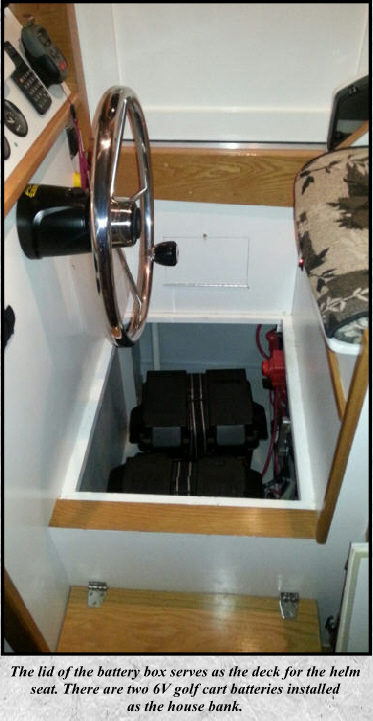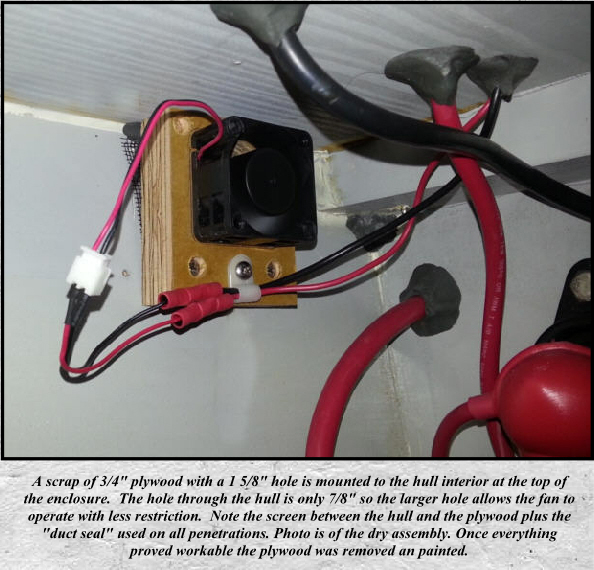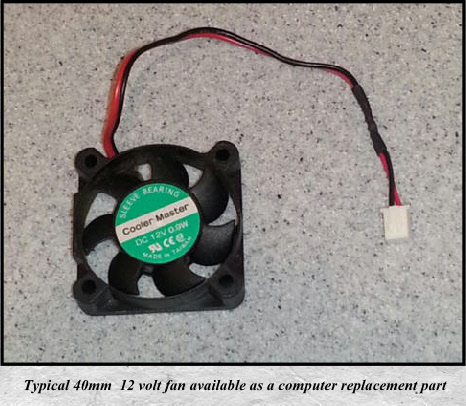
Our
fourth season using the True Grit brought about an
unusual problem. When not in use it is parked on the trailer under roof
at my
home, which is located in a heavily wooded area.
Southern Illinois has hot humid summers and the
wooded location
helps with the heat but increases the humidity. To prevent mildew I
keep it
closed up and run a small dehumidifier inside – an action that has
successfully
kept the fungi at bay. Because I have a gas heater and gas refrigerator
installed, I also have a Carbon Monoxide (CO) monitor/alarm mounted in
the
cabin.
The problem presented itself a couple days after a four-day
outing. I climbed up in the boat and the CO alarm was screaming and
it’s LED
readout showed a fairly high reading. This was curious because there
was no
source of CO in operation. I opened it up the cabin, aired it out and
shut it
up again. I reset the unit but the next day the alarm was again
sounding. I assumed
the alarm was faulty so I
installed a new one but the result was the same – the next day a high
level of
carbon monoxide was detected.
Now
I am totally confused.
How can there be CO with no source? The only items
running in the boat
were the dehumidifier and the battery charger. At a loss for an answer
I
decided to do an Internet search for other possible origins of CO that
might be
the cause. A google search yielded no other CO sources that made sense
but I did find
an interesting article about CO detectors reading the presence of
hydrogen - http://www.usfa.fema.gov/pdf/efop/efo27803.pdf
. Further reading disclosed that most all
electrochemical CO sensors will show a degree of cross sensitivity to
hydrogen.
Additional searches discovered numerous articles where CO detectors
were being
triggered by the charging of lead acid batteries in the near vicinity.
To test this theory I placed the
detector in my house battery bank enclosure (two 6 volt golf cart
batteries)
and with in a minute it was sounding with a high reading. I took the detector
outside for a while
until it read zero and brought it back into the cabin. Again it sounded. I replaced the
battery box lid and then I
opened just the hatch in the saloon roof.
In a few minutes it cleared and the detector read
zero. To me this
proved the gas was lighter than
air and self exhausted through the upper hatch. To me this more or less
confirmed it was indeed a hydrogen problem.
But why now?
The first three seasons I had all the same
equipment installed and had no problems with this.
My understanding is high hydrogen output from lead
acid batteries
is usually caused by overcharging as the result of a defective charger
or a
cell going bad. But charger was performing properly. In fact, I was
getting
this excessive hydrogen when the charger was in just the float or
maintenance
mode and showing a voltage about 13.3.
I then used a hydrometer to check the charge
status on all the
individual cells and found nothing unusual. I check with both the
charger
manufacturer (Xantrex) and the battery maker and neither offered an
advice or
explanation for the excessive hydrogen off gassing.
I will say the highest
reading I
obtained in the cabin was about 80 ppm. If the detector measures
hydrogen
accurately and I am interpreting
the data correctly it does not appear this is
anywhere near 4% level (40,000 ppm) to be an explosion risk. But I could never find
information on the
safe level to inhale lower amounts over a long period of time. I
decided the
best course of action was to improve my battery box seal and venting
system to eliminate
the unwanted gas.
 When I built the enclosure I did
include a single 7/8" hole near the top of the box. On the outside it
is
covered with a small stainless steel clamshell and behind it a piece of
screen
wire to keep out the wasp. I
also was
careful to seal the enclosure’s edges/corners and any penetrations. The
top of
the box was simply a piece of 1/2” plywood set into a recess to hold it
in
place. There
was no gasket or seal just
a nice fit with gravity holding it down. This is actually the deck when
sitting at the helm.
When I built the enclosure I did
include a single 7/8" hole near the top of the box. On the outside it
is
covered with a small stainless steel clamshell and behind it a piece of
screen
wire to keep out the wasp. I
also was
careful to seal the enclosure’s edges/corners and any penetrations. The
top of
the box was simply a piece of 1/2” plywood set into a recess to hold it
in
place. There
was no gasket or seal just
a nice fit with gravity holding it down. This is actually the deck when
sitting at the helm.
My first attempt at a solution was
simply to add a foam weather strip type gasket to improve the seal. Testing found it might
have slowed down the
process a little but still the hydrogen was escaping. Next, I decided
to try to
improve my passive vent system. I
added
a second hole through the side of the hull - one would serve as an
intake the
other an exhaust. Since
I wanted both
of these to remain high on the hull to prevent water intrusion I added
a 1”
plastic tube to serve as a duct routing the intake air to the bottom of
the
box. The new hole was added for the exhaust and was placed as high in
the
enclosure as possible. The
idea was the
lighter than air hydrogen would escape the upper hole creating a slight
vacuum
that would pull fresh air down through the tube to the bottom. In
theory this
should work but reality often tends to ignore good theories. The gas
buildup
continued.
Finally, I decided to abandon the
passive vent idea and go with power. I honestly didn’t want to do this
as it
adds additional draw on the battery (however small) and provides
another device
which I know will eventually fail. But I wanted the hydrogen
eliminated, as I
just didn’t like the idea of it being present even in low level
amounts.
Since I knew the amount of air transfer needed to keep the box clear would be minimal I decided on the smallest 12v fan that was easily obtainable – 40mm. These are very inexpensive and since they are brushless motors there is no chance of causing an explosion. An added benefit was my composting head uses the same fan for ventilation so I always carry a couple onboard as a backup. The current draw is negligible at about .9 watt or .075 amp.
 I simply made a mounting plate out
of 3/4" plywood with an 1 5/8" hole for the fan. It was glued to the
interior of the hull, centered over the
existing hole with two screws then hold the fan to it. This allows easy
removal
and replacement when needed.
I simply made a mounting plate out
of 3/4" plywood with an 1 5/8" hole for the fan. It was glued to the
interior of the hull, centered over the
existing hole with two screws then hold the fan to it. This allows easy
removal
and replacement when needed.
The biggest hassle was the wiring,
as I wanted a separate fuse and switch to control the fan. Plus, I did not
want an inline fuse but
rather utilize and existing open slot in the 12v fuse block. Not only
does it
make a cleaner install but moves the fuse outside the battery
enclosure. I am
fairly sure the ATC fuses I am using are not sealed and the arc created
when
one blows could have serious consequences in a possibly high hydrogen
environment inside the battery box. The switch was located below the
helm seat,
which is also outside the battery box and has an indicator light to
note the
fan is in operation.
To date the fan seems to have
solved the problem as in storage I have yet to see even a small reading
on the
CO detector. When the boat is in use we normally have windows and
hatches open
so I don’t run the fan as the gas is readily dispersed.
If the weather was colder and we have things
closed tight I will simply run the fan to keep the fumes at bay. In
storage I allow it to run continuously.
I honestly wish I had been able to get a passive system to work but
this solution
is frugal in both cost and energy so it is a compromise I can accept.
Still
I am curious as to why this
problem didn’t present itself until the fourth season of use. If anyone
has a
though or knowledge on this, please drop me an email. I really would
like to
better understand
the situation.
UPDATE
During
the 2014 season this situation only presented itself once. And that was
during hot weather. Other that that I have not been running the fan
during storage and have not been seeing any hydrogen buildup.
Still totally baffled as to what sets this off at times.
